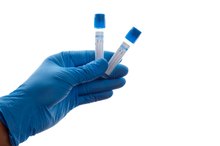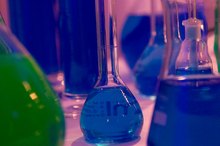What does fact checked mean?
At Healthfully, we strive to deliver objective content that is accurate and up-to-date. Our team periodically reviews articles in order to ensure content quality. The sources cited below consist of evidence from peer-reviewed journals, prominent medical organizations, academic associations, and government data.
The information contained on this site is for informational purposes only, and should not be used as a substitute for the advice of a professional health care provider. Please check with the appropriate physician regarding health questions and concerns. Although we strive to deliver accurate and up-to-date information, no guarantee to that effect is made.
What is Sodium Phosphate Monobasic?
An important chemical in your body, sodium phosphate monobasic also possesses properties highly desired in a variety of laboratory experiments 1. Working in tandem with sodium phosphate dibasic, this buffering solution helps control rapid fluctuations in pH, both in your body and in laboratory experiments. While it can be toxic, especially in combination with other drugs, sodium phosphate solutions help relieve symptoms of constipation.
Chemistry
Chemically, the formula for sodium phosphate monobasic consists of one sodium or Na atom, two hydrogen or H atoms, and one phosphate or PO4 group 1. The monohydrate form also has one associated water or H2O molecule for every molecule of sodium phosphate monobasic, or NaH2PO4+H2O 1. The term monobasic refers to the neutralization of the molecule by a single or univalent base group. When dissolved in solution, a single base group will neutralize the dissociated sodium atom. By contrast, the dibasic form of sodium phosphate having the formula Na2HPO4 +2H2O, dissociates into two sodium atoms when dissolved, requiring two basic groups to neutralize them.
- Chemically, the formula for sodium phosphate monobasic consists of one sodium or Na atom, two hydrogen or H atoms, and one phosphate or PO4 group 1.
- By contrast, the dibasic form of sodium phosphate having the formula Na2HPO4 +2H2O, dissociates into two sodium atoms when dissolved, requiring two basic groups to neutralize them.
Physical Properties
What Can Sodium Lactate Do to Your Body?
Learn More
Sodium phosphate monobasic exists as a white, odorless, crystalline powder 1. Slightly acidic, sodium phosphate monobasic has a pH of 4.5 1. The dissociated H2PO4 group has only one negative net negative charge, requiring only one hydrogen to neutralize the molecule. In contrast, the dibasic version has a much higher pH of 9.5 by virtue of the dissociated HPO4 group having a net negative charge of 2, requiring much more acid to neutralize that group. In addition, sodium phosphate monobasic boils at 399 degrees F and melts at 212 degrees F 1.
Buffering Agent
Sodium phosphate monobasic acts as a buffering agent, preventing the pH of a solution from changing when challenged by an acid or a base 1. Sodium phosphate buffers exist in all cellular fluids. Dihydrogen phosphate or H2PO4- ions act as acids while the hydrogen phosphate or HPO4 ions act as bases. These two ions are in equilibrium with each other keeping cellular fluids in a tight pH range of about 6.9 to 7.4.
- Sodium phosphate monobasic acts as a buffering agent, preventing the pH of a solution from changing when challenged by an acid or a base 1.
- Dihydrogen phosphate or H2PO4- ions act as acids while the hydrogen phosphate or HPO4 ions act as bases.
Pharmaceutical
What Is Sodium Metasilicate?
Learn More
Sodium phosphate monobasic, in combination with sodium phosphate dibasic acts as a laxative, inducing bowel movements 1. As a pharmaceutical agent, this combination helps those suffering from constipation, or as a prescription to help completely empty your bowels before surgery or other medical procedure.
Toxicity
As a pure chemical, sodium phosphate monobasic irritates your skin, eyes and respiratory tract, and can be harmful if swallowed or inhaled 1. Phosphate buffer laxatives should not be combined with other medicines without consulting a health professional. Negative reactions could result if taken in combination with drugs designed to lower blood pressure, treat depression, or manage pain, or if you are pregnant or breastfeeding, having kidney or heart or electrolyte problems or a history of seizures.
Related Articles
References
Resources
Writer Bio
Robin Wasserman has been writing and prosecuting biochemical patents since 1998. She has served as a biochemical patent agent and a research scientist for a gene-therapy company. Wasserman earned her Doctor of Philosophy in biochemistry and molecular biology, graduating from Harvard University in 1995.








